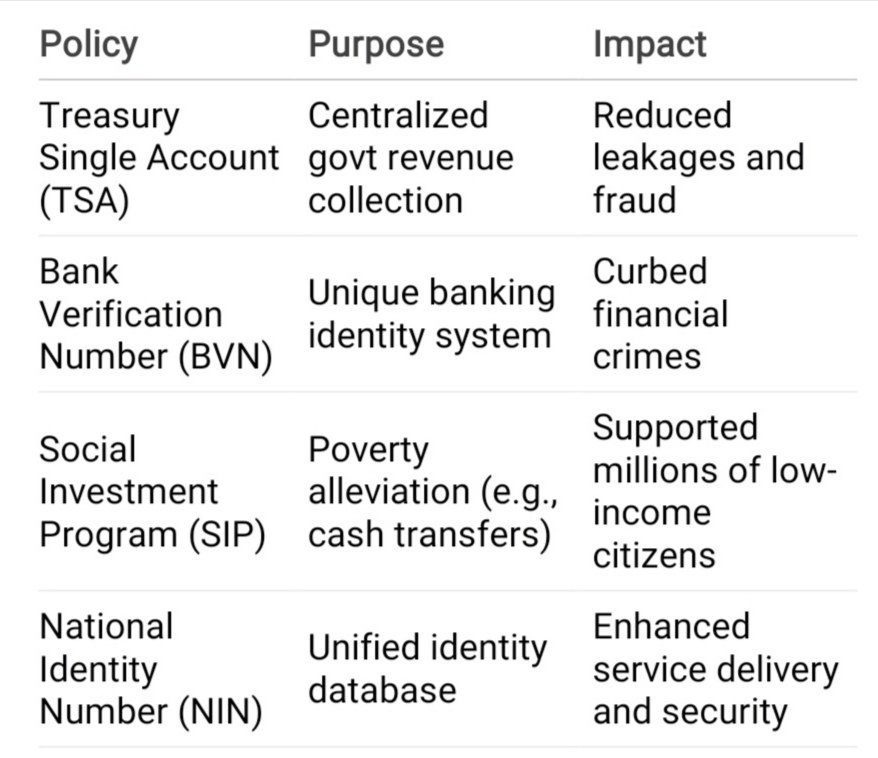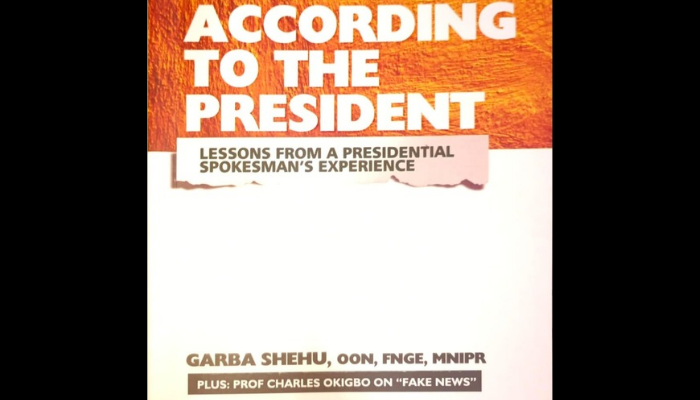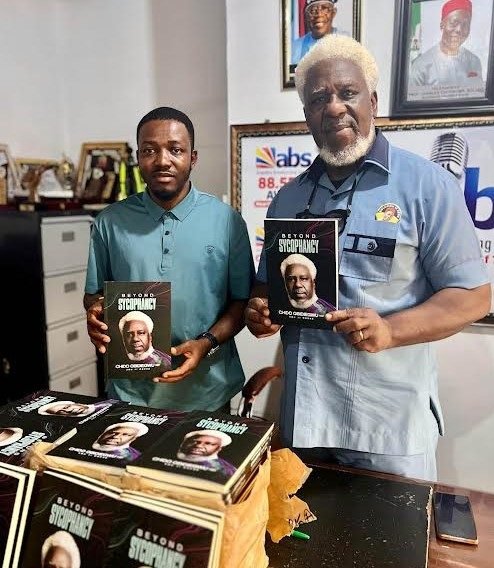Garba Shehu (2025). According to the President: Lessons from a Presidential Spokesman’s Experience. Lagos: Venturion Limited. ISBN:978-978-77505-06.
Garba Shehu intended to share his experiences and lessons as a presidential spokesman but ended up providing insights from half a century of journalism and public relations practice. Communication professionals across the field will find this book, According to the President, an instructive vade mecum, acting as a handbook or guide that is kept frequently at hand for consultation.
Shehu redefines presidential PR as the stewardship of historical truth, not just media management. His lessons emphasise that effective communication must balance: Advocacy (for the principal), Accuracy (for the public), and Archiving (for history).
Garba Shehu served as Senior Special Assistant (Media and Publicity) to President Muhammadu Buhari for eight years. Before that, he spent eight years as the spokesman for Vice President Atiku Abubakar. The combined tenures make him the individual with the longest experience in presidential communication in Nigeria.
His background makes the book an engaging and compelling read. Mallam Garba Shehu is well-educated and experienced in the two communication disciplines essential for presidential communication. He holds a master’s degree in mass communication from UNN and a first degree in Hausa from Bayero University (where he was the top graduate), with television experience at NTA and roles in print media including Editor-in-Chief and Managing Director of Triumph. He served as President of the Nigerian Guild of Editors for two years before accepting the call to serve in the presidency. He was also the General Manager of Communication at the Aluminium Smelter Company, Ikot Abasi.
Shehu discovered his appointment to Vice President Atiku Abubakar’s communications team on television. He was also dismissed from the team in the same way.
He joined Vice President Atiku’s team as tensions grew over the relationship between Atiku and President Olusegun Obasanjo. The “Reception 2000” organised by Northern interests to recognise the vice president as the highest-ranking Northerner in the new democracy was highly successful and attracted large crowds. “President Obasanjo’s courtiers interpreted the event as his vice president not only trying to upstage him but also attempting to oust him from power.” Other issues in the relationship arose, including the “Mandela Option”, through which the Atiku group aimed to persuade Obasanjo to serve only one term, and the introduction of Sharia Law by twelve Northern governors led by Zamfara State.
From marshalling media relations, Shehu entered political communication at the vortex of crisis communication.
Atiku Abubakar established a Just Cause Advisory Committee, which subsequently evolved into the Atiku Media Office (AMO) after the president dismissed Garba Shehu. Shehu then led the AMO and provided exceptional media relations support to the vice-president in a consultancy role.
The Atiku Media Office conducted a newsroom and public relations operation. They supported and influenced their principal’s reportage. “Persuasion with subtlety, not propaganda, was our operational mode”, Shehu claims.
The 158-page book’s account of the political intrigues of the Atiku-Obasanjo years is a thriller. This three-part book covers an introduction to presidential communication, the legacy of Buhari’s “revolutionary and exemplary leadership,” and a detailed account of Buhari’s administration (2015–2023).
The author shares many lessons from journalism and public relations.
Shehu continues his role as a spokesman for President Muhammadu Buhari in this book, providing a detailed view of the benefits of the government’s economic policies and programmes. He highlights programmes such as the Bank Verification Number (BVN), the Treasury Single Account (TSA), and the IPPIS Payroll Service.
The book examines challenges such as managing public perception, media relations, and crisis communication. It also shares anecdotes from reporters and editors who interacted with Shehu.
Shehu criticises President Obasanjo in subtle digs.
Lessons for journalists include
1. Be careful with sensitive documents that come to you while doing your work.
2. A journalist must help the underdog and the weak against the stronger person.
3. The journalist must do right to all manner of persons.
4. Journalists must protect their sources no matter what.
Shehu espouses his core PR principles and strategies, including “never side with the public against your boss”.
He shares his PR insights and practices.
a. The work of the public relations expert is to help alleviate or prevent crisis, as such it behoves every practitioner to eschew all likely means of creating avoidable animosity or fueling existing problems.
b. No matter the provocation, the public relations practitioner must resist any temptation to react negatively or unleash downright verbal attacks to anyone who opposes the services or actions of the person in power. There will always exist detractors and fault finders who would see only thee faults or even manufacture them.
c. A public relations practitioner should see him/herself as the proverbial person who lives in a glass house and should never throw stones.
The media has feasted on Chapter 10, “Rats, Spin And All That” since the book’s launch. It is in keeping with the dictum that man biting dog is bigger news than dog bites man.
In this chapter, Garba Shehu admits that the story about rats biting cables in Aso Rock Villa was a fable he created to shift attention from Buhari’s health. Other administration officials such as then Vice President Prof Yemi Osinbajo thought it did more harm than good. The surprise is that he still shares it in his book. To what end really? Is it to tell the truth and nothing but the truth? Or to show what may not work? The reader is invited to ascertain.
PR By The Garba Shehu Playbook
1. Crisis Communication Mastery
o Calm Under Pressure: Shehu emphasised the importance of responding to crises with factual, constructive messaging, avoiding personal attacks despite intense scrutiny.
o Proactive Transparency: During controversies (e.g., security challenges), his team pre-empted misinformation by releasing verified updates, acknowledging gaps while highlighting solutions.
2. Ethical Loyalty vs. Spin
o Shehu rejected “spin,” portraying his role as maintaining unwavering loyalty to Buhari while honestly representing the facts. This involved refusing to distort the truth, even when under pressure to “massage” uncomfortable truths.
o Example: His documentation of Buhari’s transparency policies (TSA, BVN) aimed to build credibility, not merely enhance the administration’s image.
3. Digital Age Adaptation
o Managing the “4Vs”: Handling digital information’s Volume, Velocity, Variety, and Veracity by prioritising swift rebuttals to viral misinformation and segmenting audiences for tailored messaging.
o Countering disinformation: Delivered strategic briefings and used social media to challenge false narratives during the 2015 elections and governance crises.
Practical Tactics & Institutional Practices
4. Relationship Capital as Currency
o Building trust with journalists, security agencies, and opposition figures facilitated smoother information flow. Shehu attributes his survival during DSS arrests to pre-existing media relationships. Curiously, he went to jail while working in public relations, but the prosecution linked the offence to his work as an editor.
o Lesson: “Never burn bridges—today’s critic could be tomorrow’s ally”.
5. Archiving as Reputation Insurance
o Meticulous records of speeches, policies, and media interactions provided an “institutional memory” to validate claims during disputes (e.g., documenting SIP’s impact to counter poverty-alleviation criticisms).
6. Humanizing Leadership
o Shehu changed Buhari’s “aloof” perception by sharing personal anecdotes: his modest wardrobe, daily routines, and commitment to thriftiness. This made Buhari more relatable without compromising his dignity.
Navigating Political Pitfalls
7. Multi-Principal Challenge
o Serving both the office (presidency) and the individual (Buhari) required reconciling institutional messaging with personal loyalty. Shehu addressed this by aligning Buhari’s values (integrity, transparency) with policy branding.
8. Transitioning Allegiances
o Moving from Atiku’s to Buhari’s team drew accusations of opportunism. Shehu framed this as professional evolution, stressing that ethical service to successive principals is possible if grounded in principles.
9. Handling High Expectations
o Buhari’s “tyranny of high expectations” meant even substantive policies (e.g., infrastructure upgrades) faced public scepticism. Shehu’s approach: underpromise, overdeliver, and spotlight incremental wins.
10 Actionable PR Lessons from the Book
Lesson
Application Example
1. Proximity Demotes Discretion
Withheld sensitive policy debates until official decisions were finalized.
2. Credibility > Convenience
Refused to deny Buhari’s health struggles; instead framed them as temporary challenges.
3. Segment Your Audiences
Tailored SIP messaging: data-driven pitches for elites, emotional narratives for masses.
4. Mentor Relentlessly
Groomed junior staff to handle niche issues (e.g., economic reporting).
5. Spin Invites Backlash
Avoided exaggerating military gains; acknowledged “progress amid challenges”.
6. Leverage Third-Party Voices
Amplified independent validators (e.g., IMF praise for TSA reforms).
7. Digital Vigilance
Monitored trending hashtags for real-time rebuttals (e.g., #BuhariHealth).
8. Document Rigorously
Archived all press interactions to pre-empt misquotes.
9. Embrace Constructive Critics
Engaged critical editors for off-record briefings, converting adversaries to allies.
10. Exit with Grace
Post-tenure, avoided public critiques of successors; offered advice only when asked.
Eminent persons launched the book, According to the President, on Wednesday, 9 June. President Bola Tinubu praised the book for its contribution to Nigeria’s democratic literature, while former Vice President Atiku Abubakar declared that it is a must-read
Table: Key Buhari-Era Policies Documented in the Book:




























